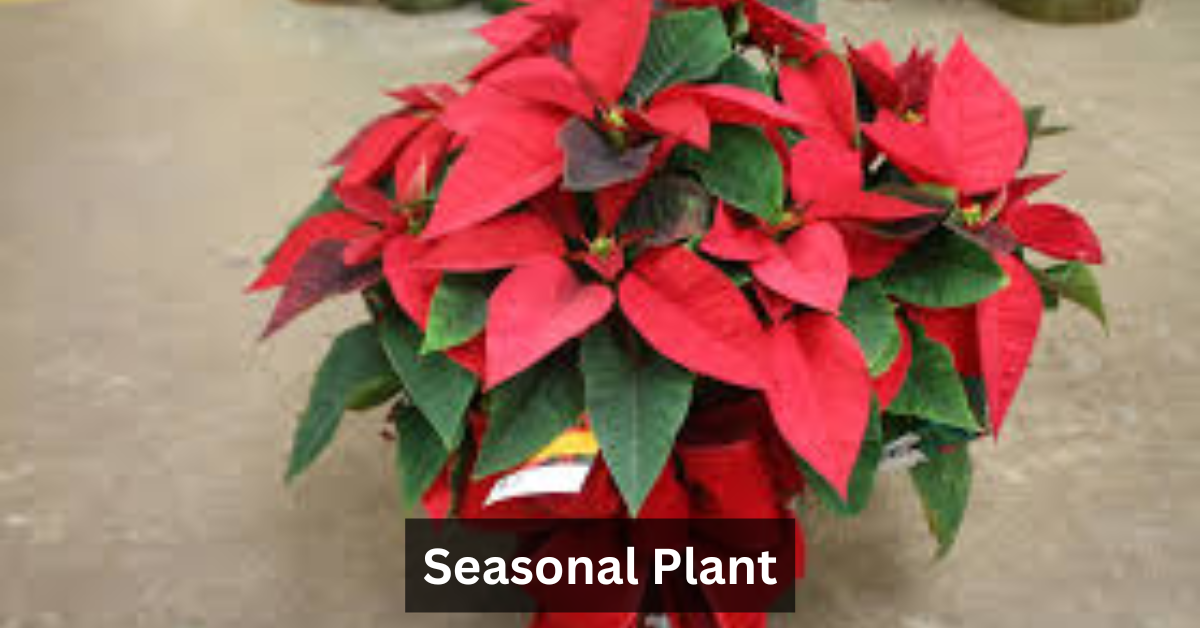It’s a plant that thrives and blooms in a specific season, completing its growth cycle in a short period. These vibrant, adaptive plants are specifically cultivated to bloom and thrive in particular seasons, allowing gardeners to enjoy continuous bursts of color, texture, and fragrance throughout the year. Whether you have a compact balcony garden or a sprawling backyard, understanding how to choose, plant, and care for the right Seasonal Plant can dramatically elevate your garden’s charm and ecological value. This guide is your all-in-one resource to master Seasonal Planting for every climate and lifestyle.
A Seasonal Plant is a type of plant that grows, flourishes, blooms, and completes its life cycle within a specific season—be it spring, summer, fall, or winter. These plants are genetically aligned with particular climatic conditions, meaning they take advantage of favorable temperatures, rainfall, and sunlight patterns to thrive. Whether it’s the radiant Marigold in summer or the gentle Pansy in winter, each Seasonal Plant offers a unique contribution to the garden’s landscape. Typically, these plants are categorized into annuals, biennials, or perennials depending on how long they live and bloom.
While the term Seasonal Plant is often used interchangeably with annuals or biennials, there’s a broader context to understand. Annual plants, like Zinnias and Sunflowers, complete their life cycle within one growing season and then perish. Perennials, such as Lavender, return every year but often bloom in a particular season. A Seasonal Plant may fall into either category, but the focus is more on when it blooms rather than how long it lives. This distinction helps gardeners plan for a constantly evolving and seasonally appropriate landscape, one that feels fresh all year.
Why Choose Seasonal Plants for Your Garden?
Benefits of Seasonal Gardening
Incorporating Seasonal Plants for garden planning brings a host of benefits. First, it provides constant variety and aesthetic interest. From the first Tulips of spring to the golden Chrysanthemums of fall, there’s always something new to look forward to. Second, Seasonal Plant gardening is cost-effective; these plants grow fast, produce bountiful blooms, and often require less maintenance due to their natural adaptation to local weather patterns. For novice gardeners or those with limited time, these quick-to-bloom beauties offer satisfaction without the long wait.
Environmental and Aesthetic Advantages
The environmental benefits of planting by season are significant. Seasonal Plants are less reliant on synthetic fertilizers and pesticides because they’re already acclimated to the prevailing conditions. This results in more sustainable, eco-friendly gardening. Additionally, rotating seasonal garden plants ensures the soil remains healthy and reduces the risk of pests and diseases building up. Visually, the garden becomes a dynamic space that reflects the changing seasons, offering new textures, colors, and scents throughout the year.
Seasonal Planting for Pollinators
If you care about biodiversity, Seasonal Planting is a must. Bees, butterflies, and other pollinators rely on a continuous supply of nectar-rich blooms. By rotating your garden with seasonal flowering plants, you support these vital creatures year-round. Spring’s Snapdragons and Daffodils give way to summer’s Zinnias and Marigolds, followed by Asters and Kale in autumn, and finally the winter-defiant Calendula and Pansies. Every Seasonal Plant has its ecological role to play.
Types of Seasonal Plants Based on Climate
Summer Seasonal Plants
Summer Seasonal Plants thrive in full sun, longer days, and warmer temperatures. Marigold, Zinnia, and Sunflower are some of the best choices, offering bold colors and quick blooms. These plants are perfect for containers, borders, and even vegetable garden companions. Using soil enriched with Miracle-Gro or Scotts fertilizers can boost their growth. If you’re planning a summer refresh, check out seasonal varieties specifically labeled for high heat tolerance to ensure vibrant blooms all summer long.
Winter Seasonal Plants
Don’t let the cold fool you—winter gardens can be just as colorful. Winter Seasonal Plants such as Pansy, Dianthus, and Calendula are frost-tolerant and add cheer when most plants go dormant. They often feature rich purples, reds, and yellows that contrast beautifully against the subdued winter landscape. Mulching is key to protecting roots from extreme cold, especially in USDA Planting Zones prone to frost.
Spring Seasonal Plants
When nature awakens, spring seasonal flowers burst forth in a riot of colors. Think Tulips, Daffodils, and Snapdragons. These plants are often started from bulbs planted in autumn and make the most of spring’s mild temperatures and rain. A Seasonal Plant like Tulip not only offers elegance but also naturalizes over time, spreading beauty year after year.
Autumn Seasonal Plants
As temperatures cool, fall garden plants like Chrysanthemum, Asters, and Ornamental Kale dominate. These are ideal for borders and decorative pots. A Seasonal Plant suited for autumn adds a warm, cozy feel and pairs beautifully with fall décor. They also serve as important nectar sources for late-season pollinators.
Annuals, Biennials, and Perennials: What’s the Difference?
Choosing the Right Type for Your Needs
Selecting the right Seasonal Plant depends largely on your goals. Want quick color? Go with annuals. Looking for low-maintenance returns? Choose perennials. Biennials offer a balance, taking two seasons to complete their life cycle. Each has its place in a balanced seasonal garden.
Planting Cycles Explained
Understanding the plant life cycle helps in scheduling your planting. Annuals bloom in one go; biennials may stay leafy in year one and flower in year two; perennials return stronger each season. Knowing these cycles means you can create a seamless rotation of Seasonal Plants that always look fresh and full.
Top 10 Seasonal Plants to Grow by Season
Best Plants for Spring Gardens
- Tulip
- Daffodil
- Snapdragons
- Hyacinth
- Pansy
Must-Have Plants for Summer Color
- Zinnia
- Marigold
- Sunflower
- Petunia
- Cosmos
Ideal Plants for Fall Foliage
- Chrysanthemum
- Asters
- Ornamental Kale
- Sedum
- Goldenrod
- Cold-Hardy Plants for Winter
- Calendula
- Dianthus
- Pansy
- Hellebore
- Viola
Check out these best Seasonal Plants in local nurseries or online garden centers to match your zone and aesthetic needs.
How to Select the Right Seasonal Plant for Your Region
Understanding USDA Plant Hardiness Zones
Your success with a Seasonal Plant starts with knowing your USDA Hardiness Zone. These zones define the coldest temperatures your area experiences, guiding you to pick plants that won’t just survive but thrive.
Soil Type and Sunlight Needs
Don’t forget the foundation—soil pH, drainage, and sunlight exposure all matter. Most seasonal flowering plants need well-draining, slightly acidic soil and plenty of sunshine. For shaded areas, pick low-maintenance Seasonal Plants adapted for partial light.
Local Climate Considerations
Mediterranean climates support both spring and fall planting, while tropical regions offer almost year-round options. Knowing your local climate ensures you get the best from every Seasonal Plant you grow.
Planting and Caring for Seasonal Plants
Soil Preparation and Fertilization
Start with clean, enriched soil. Use compost or organic fertilizers from brands like Burpee Seeds for a natural boost. A well-fed Seasonal Plant is more resilient to pests and blooms profusely.
Watering and Mulching
Regular watering keeps your plants happy, but drainage is just as crucial. Add mulch around each Seasonal Plant to retain moisture and reduce weed growth, especially in hot summers or cold winters.
Pruning and Pest Control Tips
Deadheading faded flowers encourages new blooms. Companion planting with Marigolds can deter common garden pests, making your Seasonal Plant setup more sustainable.
Designing a Year-Round Seasonal Plant Garden
Rotating Seasonal Blooms
Smart gardeners rotate their blooms. When spring ends, replace bulbs with summer Seasonal Plants, and follow up with fall foliage options. This keeps the garden visually dynamic and continuously active.
Using Containers and Raised Beds
Seasonal potted plants make rotation easy and perfect for limited spaces. Raised beds offer improved drainage and easier maintenance.
Creating Color Themes for Each Season
From pastel spring palettes to bold summer brights and warm autumn hues, color planning elevates your Seasonal Plant design into art. Don’t just plant—design with purpose.
Seasonal Plant Maintenance Tips for Beginners
Tools and Supplies Checklist
- Garden trowel
- Watering can
- Seed trays
- Mulch
- Natural fertilizers
- Gloves
Monthly Garden Care Calendar
Align care tasks with your planting calendar. Sow in early spring, fertilize in summer, prune in fall, mulch in winter. This rhythm supports healthy Seasonal Plants year-round.
Common Mistakes to Avoid
Avoid overwatering, overcrowding, and ignoring sunlight needs. The right Seasonal Plant in the wrong spot won’t thrive.
Indoor Seasonal Plants and Decorative Ideas
Houseplants That Change with the Seasons
Rotate your indoor greenery with miniature Seasonal Plants like Poinsettias in winter or Sunflowers in summer. These little changes bring the beauty of nature indoors.
Tabletop and Balcony Garden Ideas
Use seasonal potted plants in colorful containers to brighten balconies, windowsills, or tables. Choose a theme per season for a stylish effect.
Sustainable Gardening with Seasonal Plants
Eco-Friendly Gardening Practices
Focus on composting, recycling, and using non-toxic methods. Seasonal Plant gardening naturally reduces chemical use due to its adaptability.
Companion Planting and Natural Fertilizers
Pairing the right plants together boosts soil health and wards off pests. A sustainable garden starts with choosing the right Seasonal Plant combinations.
Seasonal Plants for Special Occasions
Plants for Holidays and Celebrations
Gift a pot of Tulips for Easter, Chrysanthemums for Thanksgiving, or Poinsettias for Christmas. Every Seasonal Plant tells a story and adds meaning to memories.
Gifting Ideas with Seasonal Blooms
Check out local florists who offer seasonal flowering plants in creative arrangements—great for birthdays, anniversaries, or even just to say “thank you.”
Where to Buy Seasonal Plants and Seeds
Local Nurseries vs. Online Stores
Shop local to support community growers or go online for more variety. Brands like Miracle-Gro, Scotts, and Burpee Seeds offer trusted quality and detailed instructions.
Recommended Brands and Seed Catalogs
Choose brands that list USDA zones, growth time, and care tips. This ensures every Seasonal Plant has the best chance to succeed.
Conclusion
A Seasonal Plant isn’t just a garden addition—it’s a living celebration of time, change, and renewal. With the right planning, tools, and love, anyone can cultivate a thriving space that reflects nature’s beauty year-round. Start today, and check out your local garden center to bring your seasonal vision to life.
Frequently Asked Questions
What are the best Seasonal Plants for beginners?
Marigolds, Pansies, and Zinnias are beginner-friendly and require minimal effort.
Can I grow Seasonal Plants indoors?
Yes! Just ensure proper sunlight, container drainage, and seasonal rotation.
How do I maintain a seasonal garden year-round?
Plan your planting calendar, rotate blooms, and prepare the soil before every new season.
Stay in touch to get more updates & alerts on Erome! Thank you



